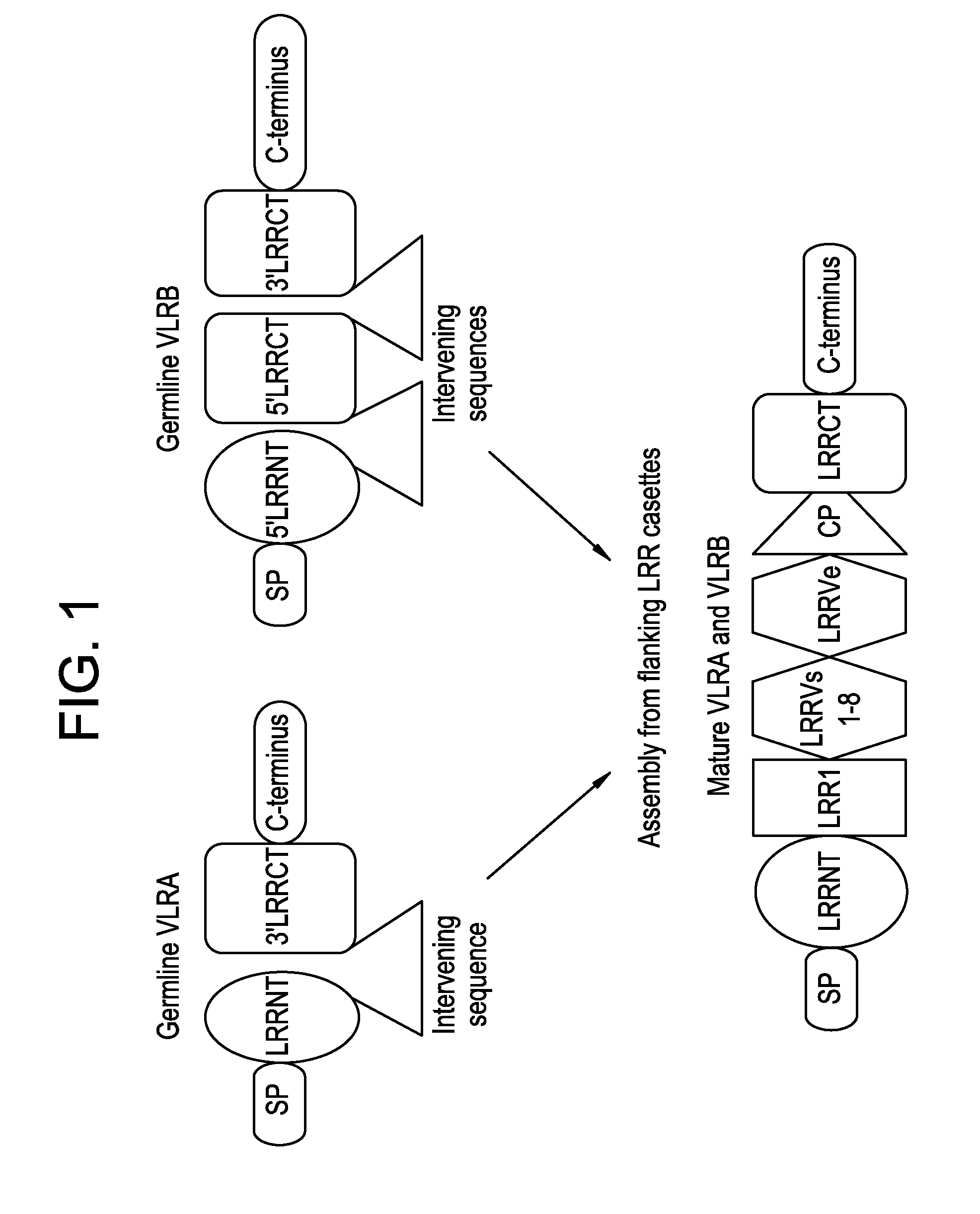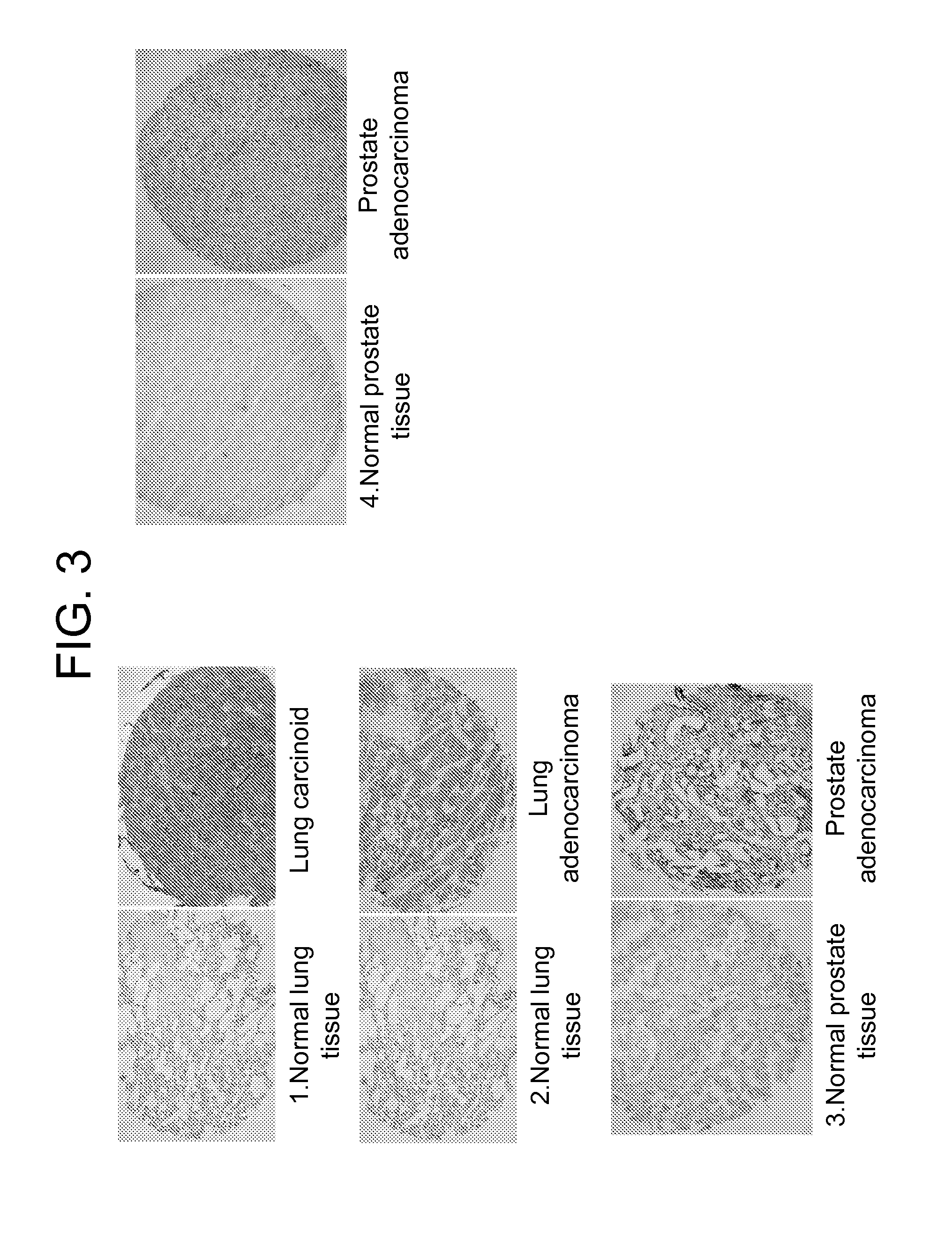Lambodies with high affinity and selectivity for glycans and uses therefor
a glycan and high affinity technology, applied in the field of dimeric proteins, can solve the problems of most readily available glycan-binding proteins, mammalian antibodies, limited clinical utility, and poor specificity
- Summary
- Abstract
- Description
- Claims
- Application Information
AI Technical Summary
Benefits of technology
Problems solved by technology
Method used
Image
Examples
example 1
[0091]Practically all types of human tumor cells express glycoproteins with aberrant glycosylation patterns (Varki et al., 2009; Almogren et al., 2012). The best studied cancer-specific carbohydrates are truncated 0-glycans such as the T-nouvelle antigen (Tn, GalNAcα1-Ser / Thr) and TFα (Galβ1-3GalNAcaα1-Ser / Thr), both considered pancarcinoma antigens that uniquely decorate mucin-type glycoproteins in about 90% of human cancer cells, but are distinctly absent from nearly all normal tissues.
[0092]Isolation of Lambodies Reactive to Tumor-Associated Carbohydrate Antigens.
[0093]A library of yeast surface-displayed (YSD) lamprey variable lymphocyte receptors (VLRs) was screened for clones that can selectively bind chosen glycoproteins and / or glycans. Clones that can bind TFα were isolated from a library of 1.2×108 independent clones (Tasumi et al., 2009) using as antigen a synthetic polyacrylamide (PAA) glycoconjugate of TFα. The first batch of clones that was isolated could discriminate b...
example 2
[0140]Lambodies display exquisite affinity and selectivity for glycans that is superior to that of most antibodies and lectins. Therefore, lambodies can be utilized to enhance the sensitivity and specificity of noninvasive cancer diagnostic assays. This can be done by lambody-sandwich assays, using immobilized lambodies to capture glycoprotein biomarkers from body fluid samples such as blood, urine or plasma. The captured glycoproteins are then overlaid with a second set of lambodies, for identification of cancer-specific complexes, as shown in FIG. 9. This is an example for the use of anti-fucose lambodies, but this assay can also be performed with sets of anti-NeuGc, or with any combination of anti-glycan lambodies. The assays can be performed in ELISA plates, or in printed lambody microarrays for high-throughput multiplexed analysis, or in biosensors for label-free detection. The lambody-sandwich assays can be used to predict early risk of cancer, for diagnosis, prognosis, and to...
example 3
[0141]The lambody-sandwich assay described in Example 2 can also be performed with sets of anti-NeuGc lambodies or lambody multimers that can distinguish body fluid samples of cancer patients from normal individuals. In a preliminary screen, five lambodies have been isolated that preferentially bind surface glycoproteins from a breast cancer cell line (MCF7), compared to matching normal breast (MCF10A), lung cancer (A549) and normal lung (HBE3) cell lines (FIG. 10). These lambodies display 17 to 72-fold higher binding values for breast cancer than for normal breast antigens, and they are also non-reactive with lung antigens. They were selected from the yeast surface-display library (Tasumi et al., 2009; Hong et al., 2012) using a combination of probes including synthetic glycans (Fucose, Lewis antigens and NeuGc) and cell-surface glycoproteins from breast cancer and normal cell lines, as well as the proteins they release in cultures (conditioned medium).
[0142]While the invention has...
PUM
| Property | Measurement | Unit |
|---|---|---|
| Molar density | aaaaa | aaaaa |
Abstract
Description
Claims
Application Information
 Login to View More
Login to View More - R&D
- Intellectual Property
- Life Sciences
- Materials
- Tech Scout
- Unparalleled Data Quality
- Higher Quality Content
- 60% Fewer Hallucinations
Browse by: Latest US Patents, China's latest patents, Technical Efficacy Thesaurus, Application Domain, Technology Topic, Popular Technical Reports.
© 2025 PatSnap. All rights reserved.Legal|Privacy policy|Modern Slavery Act Transparency Statement|Sitemap|About US| Contact US: help@patsnap.com



